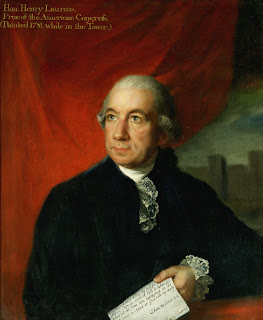Susan reporting:
While the name of Henry Laurens (1724-1792) doesn't jump to the minds of most modern Americans as swiftly as does Thomas Jefferson or George Washington, he was another of the Founding Fathers, and an important figure in the American Revolution. A native of Charleston, South Carolina, Laurens was an influential man, a wealthy merchant, plantation owner, slave-trader, and rice planter. Prominent in colonial politics, he hoped for reconciliation with Great Britain rather than a complete break. But as relations with Britain worsened, he joined the revolutionary effort, serving as a delegate to the Continental Congress and later as its president.
The choice for revolution was not an easy one for men like Laurens with strong personal ties to England. His decision was not lightly made, and his conscience continued to be troubled by conflicting loyalties to the English Crown and to the fledgling country of his birth.
In 1779, Laurens was named by Congress as minister to the United Provinces (now The Netherlands.) Returning from a mission in Amsterdam in 1780, Laurens' vessel, the Continental packet Mercury, was captured by the British Navy off the banks of Newfoundland. He attempted to destroy his papers by throwing them over the side, but the British retrieved the pages from the water. The documents were considering sufficiently damning for Britain to declare war on the Dutch, and for the Navy ship to carry Laurens to London as a political prisoner. After being lodged briefly in Scotland Yard, he was charged with suspicion of high treason, and transferred to the Tower of London.
Laurens was the first and only American ever to be imprisoned in the Tower. The British realized the significance of their prisoner. As Laurens recorded in his diary, on his arrival at the Tower, "the guards on parade [chose] the tune of Yankee Doodle, played, I suppose, in derision of me, [but instead the tune] filled my mind with a sublime contempt & rather made me cheerful." He was held in the Tower for fifteen months, and was finally released on bail in December 1781. Soon after, he was officially exchanged for Lord Cornwallis, and permitted to continue his diplomatic work. With John Adams, Benjamin Franklin, and John Jay, he negotiated the first draft of the peace treaty with Great Britain – the peace he had always wanted.
For the most part, Laurens was treated as a gentleman in the Tower, without the physical hardships often faced by lesser prisoners during the war. He suffered small, calculated deprivations, such as being denied paper and pen for writing, but he was permitted visitors, and he sat for the portrait, above left, while he was a prisoner. In this picture, the walls of the Tower are visible through the window, and Laurens' sober expression is reinforced by the text of the letter in his hand: "I have acted the part of a faithful subject. I now go resolved still to labour for peace at the same time determined in the last event to stand or fall with my country. I have the honour to be Henry Laurens."
Above: Henry Laurens, by Lemuel Francis Abbott, 1781, United States Senate.
Many thanks to the Learning Team of the Historic Royal Palaces (including the Tower of London, Hampton Court Palace, the Banqueting House, Kensington Palace, & Kew Palace) for their help with this post. If you're on Twitter, please follow them for interesting historical information of all kinds: @HRP_learning.
Laws Concerning Women in 1th-Century Georgia
1 year ago

 One of us --
One of us -- 



6 comments:
I had no idea any American citizens had ever been a prisoner in the Tower especially for Treason! I bet the British were thrilled to get their hands on a colonist who was as important as Henry Laurens. He's lucky he got out.
It would have only made matters worse if he had been executed for treason. I imagine that the British probably wanted to use him as a bargaining chip all along. Love the Yankee Doodle story. I was surprised to find Ohio's only Revolutionary War-era fort named for him:
"Fort Laurens was built in late November, 1778, on the banks of the Tuscarawas River near what is now Bolivar, Ohio. General McIntosh named the fort in honor of the President of the Continental Congress, Henry Laurens" Built on the Great Trail as McIntosh's troops marched towards Detroit/Sandusky towns, it was mostly staffed by VA militia troops and was attacked repeatedly by Indian, Loyalist and British troops. More than 20 American soldiers were killed here and Ft. Laurens is home to The Tomb of the Unknown Patriot of the American Revolution.
What an interesting and amazing story! I never realized an American had been held at the Tower. Thank you for posting this.
Thanks for the Americana. I never knew about Henry Laurens, but he must have been a man of character to have inspired such treatment from the hands of the British. Or maybe they were just less warlike at home.
I am glad we got such a trade for Cornwallis. Did we get anything else besides Cornwallis' sword?
I hadn't heard about Henry Laurens before even tho I always pay attention to bits about this period. Thanks for the info.
The first place I came across this story was a UK mini series on the Tower of London spotlighted Laurens' imprisonment. Your article puts flesh and life on an historical figure that deserves to be better known.
Post a Comment